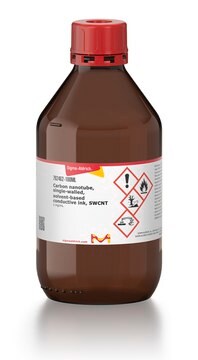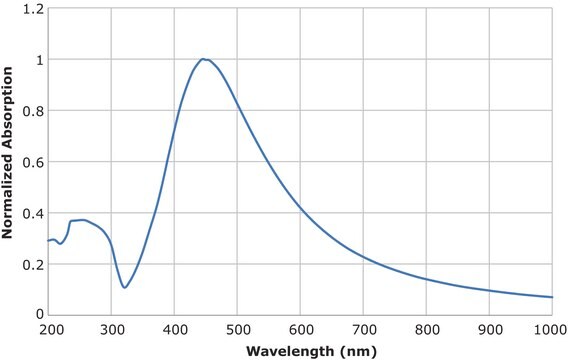791903
Conductive silver printing ink, resistivity 30 - 35 μΩ-cm
Synonim(y):
Dyesol® DYAG350 conductive silver ink, Screen printable silver paste
About This Item
Polecane produkty
opis
volume resistivity 30 - 35 μΩ-cm at a 180°C cure temperature
Formularz
paste (white)
skład
Solids content, 65-75%
lepkość
6000-9000 mPa.s (at shear rate of 10 sec-1 at 25°C)
Opis ogólny
Zastosowanie
This Conductive Silver Printing Ink is comprised of a mixture of pure silver particles and organometallic silver compound in an organic medium. When printed on polyester (PET or PEN) films and then cured at 150 - 180°C, the particles consolidate to form a chemically-welded, continuous silver track to yield low bulk resistivity.
Informacje prawne
Hasło ostrzegawcze
Warning
Zwroty wskazujące rodzaj zagrożenia
Zwroty wskazujące środki ostrożności
Klasyfikacja zagrożeń
Aquatic Acute 1 - Aquatic Chronic 1 - Eye Irrit. 2 - Skin Irrit. 2
Kod klasy składowania
10 - Combustible liquids
Klasa zagrożenia wodnego (WGK)
WGK 3
Temperatura zapłonu (°C)
79 °C
Wybierz jedną z najnowszych wersji:
Certyfikaty analizy (CoA)
Nie widzisz odpowiedniej wersji?
Jeśli potrzebujesz konkretnej wersji, możesz wyszukać konkretny certyfikat według numeru partii lub serii.
Masz już ten produkt?
Dokumenty związane z niedawno zakupionymi produktami zostały zamieszczone w Bibliotece dokumentów.
Klienci oglądali również te produkty
Produkty
The ability to pattern conductive electrodes is technologically relevant for several applications, including photovolatics, displays, sensors, and biomedical devices.
Dye-sensitized solar cells (DSCs) are 3rd generation solar cells combining the promise of high efficiency with low production costs.
Professor Tokito and Professor Takeda share their new materials, device architecture design principles, and performance optimization protocols for printed and solution-processed, low-cost, highly flexible, organic electronic devices.
Recent progress in the area of solution-processed functional materials has led to the development of a variety of thin-film optoelectronic devices with significant promise in the industrial and consumer electronics fields.
Nasz zespół naukowców ma doświadczenie we wszystkich obszarach badań, w tym w naukach przyrodniczych, materiałoznawstwie, syntezie chemicznej, chromatografii, analityce i wielu innych dziedzinach.
Skontaktuj się z zespołem ds. pomocy technicznej







